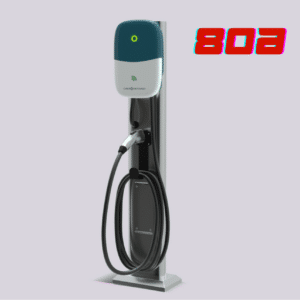As electric vehicle (EV) adoption continues to rise, choosing the right home charger becomes crucial for convenience and efficiency. One of the key decisions you’ll face is whether to opt for a tethered or untethered EV charger. Both have their own set of advantages and potential drawbacks. Let’s explore these two types of chargers to help you decide which is the best for your needs.
Tethered EV Chargers
This type of charger is designed for maximum convenience, allowing you to plug in and charge your EV without any additional steps.
Advantages
- Convenience. Tethered chargers come with a built-in cable, making it easy to plug in your EV without having to retrieve and connect a separate cable.
- Speed. They often support faster charging speeds, as the cable and connector are specifically designed for the charger and vehicle compatibility.
- Reduced Wear and Tear. Since the cable is permanently attached, there’s less wear and tear on the connectors from constant plugging and unplugging.
- User-Friendly. Ideal for daily use due to their plug-and-go nature, making the charging process straightforward and quick.
Disadvantages
- Cable Length Limitation. The cable length is fixed, which can limit where you park your EV relative to the charger.
- Less Flexible. You’re limited to the cable that comes with the charger, which may not be suitable for all parking configurations or future vehicle purchases.
- Aesthetics. A permanently attached cable can look messy if not properly managed, potentially affecting the aesthetic of your home or garage.
Untethered EV Chargers
Untethered EV chargers, also known as socketed chargers, offer a high level of flexibility by allowing you to use a variety of cables. This makes them particularly suitable for households with multiple electric vehicles or those planning future upgrades. However, this versatility comes with its own set of advantages and disadvantages.
Advantages
- Flexibility. Untethered chargers allow you to use different cables, making it versatile for various EVs with different charging port locations.
- Cable Management. You can choose the cable length that best suits your setup, providing more flexibility in how you park and charge your vehicle.
- Neat Appearance. Without a permanent cable, the charger can appear cleaner and more discreet when not in use.
- Future-Proofing. Ideal for households with multiple EVs or for those planning to switch vehicles, as you can simply swap out the cable as needed.
Disadvantages
- Convenience. You have to connect and disconnect the cable each time, which adds an extra step to the charging process.
- Additional Costs. You might need to purchase separate cables if you have multiple vehicles or if the included cable is not sufficient.
- Risk of Misplacement. The cable can be misplaced or forgotten, especially if it’s regularly transported or used in different locations.
Which is Best for You?
Deciding between tethered and untethered EV chargers depends on your specific needs and lifestyle
Consider Your Charging Habits
- Daily Routine. If you prefer a hassle-free, quick plug-in process, a tethered charger might be more suitable.
- Multiple EVs. If you have or plan to have multiple EVs, an untethered charger offers more flexibility.
Think About Your Parking and Setup
- Fixed Parking Spot. If you always park in the same spot with the charging port in a consistent location, a tethered charger with an appropriately long cable could be perfect.
- Variable Parking. If your parking position varies or you need to charge different vehicles, an untethered charger might be the better option.
Future Considerations
- Vehicle Upgrades. If you plan to switch EVs or add more to your household, untethered chargers provide the flexibility to adapt without changing the entire setup.
- Home Aesthetics. Consider how the charger will look in your space. An untethered charger can provide a cleaner appearance when not in use.
Conclusion
Choosing between tethered and untethered EV chargers depends on your specific needs, charging habits, and future plans. Tethered chargers offer convenience and ease of use, making them ideal for routine daily charging. Untethered chargers provide flexibility and adaptability, perfect for households with multiple or changing EVs. Evaluate your personal circumstances to decide which type of charger will best support your EV lifestyle.
Featured Products
-
 Add To Cart Select options
Add To Cart Select options
Nick Zamanov is a head of sales and business development at Cyber Switching. He is an expert in EV infrastructure space and he is an EV enthusiast since 2012, Since then Nick strongly believed that electric vehicles would eventually replace Internal Combustion Engine (ICE) cars.



